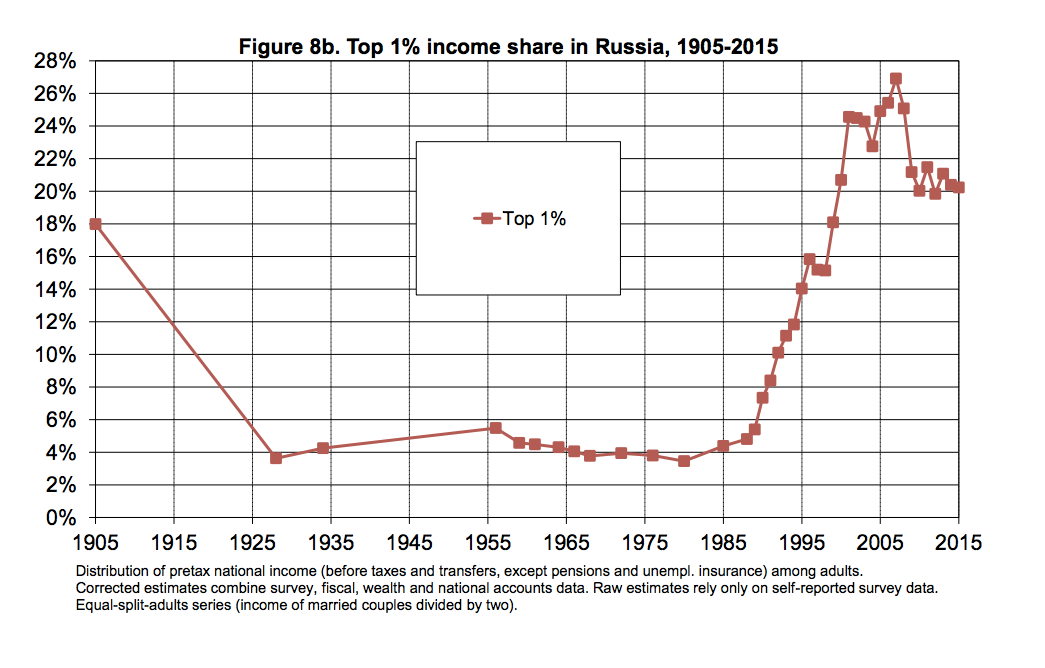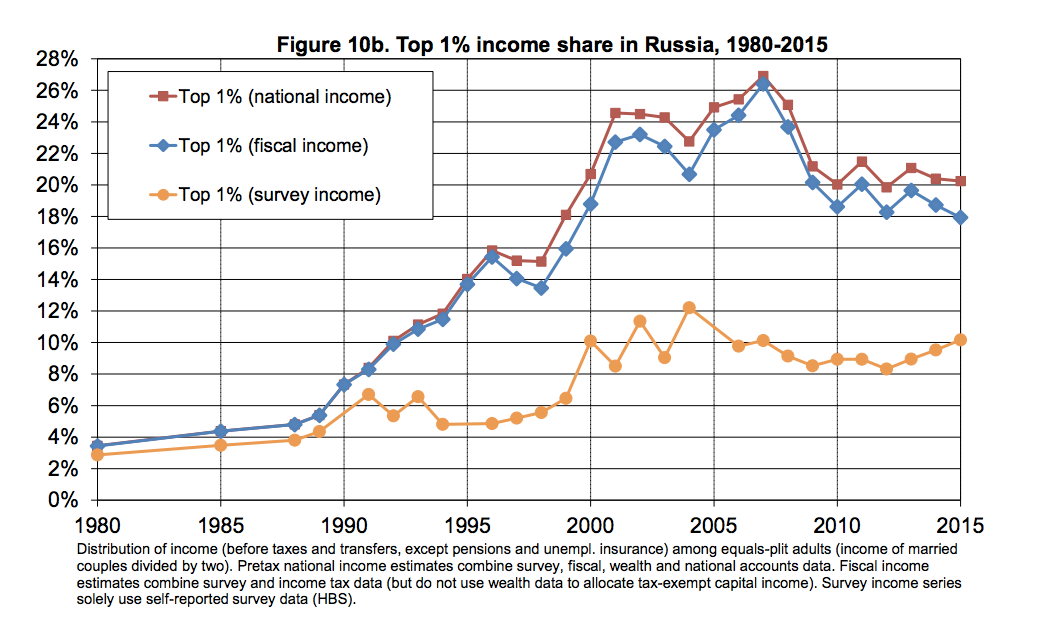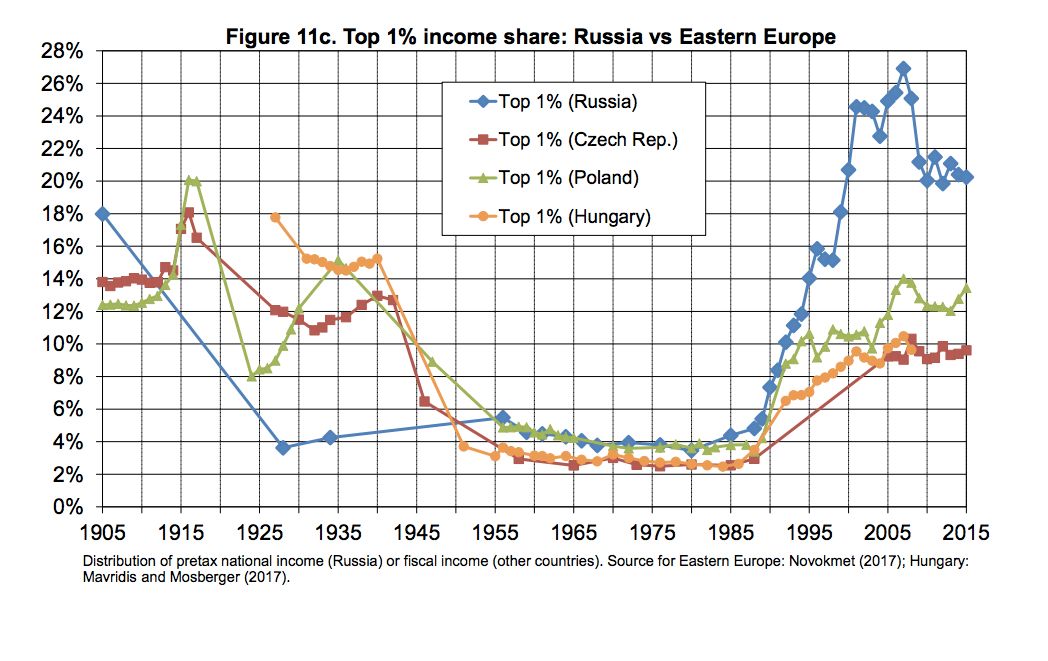Politics in the United States might look increasingly like Russia, with a macho president who bashes the press, promotes loyal propagandists, contests elections and winks at white nationalists. But when it comes to how wealth is distributed, Russia ― where for 69 years the Soviet Union attempted a radical policy of income equality ― is looking a lot more like the U.S.
Top income shares are now at least as high as the U.S., with the richest 1 percent of the population controlling 20 to 25 percent of earnings, according to a new study by three of the world’s most renowned economists researching income inequality. The analysis identifies major flaws in official Russian income estimates, and purports to be the “first complete balance sheet” of private, public and national wealth in post-Soviet Russia.
In the U.S., the top 10 percent earns about 47 percent of the total income, or about 4.7 times the average, pre-tax income, the research found. In Russia, the top 10 percent income share is about 45 percent of the total, earning about 4.5 times the average income.

“Russia and the U.S., these are probably two of the most unequal countries in the world,” Gabriel Zucman, an economist at the University of California at Berkeley and one of the study’s authors, told HuffPost by phone this week. “Those are the two leaders when it comes to extreme income and wealth inequality.”
The two countries diverge, however, over how economic inequality got so pronounced.
The Soviet government afforded clear luxuries and opportunities to party leaders, but managed to achieve reductions in income inequality. The top 1 percent’s share of income fell from about 18 percent in 1905 to 4 percent shortly after the Bolsheviks gained full control over Russia in 1922.
Such a revolution never took place in the capitalist U.S., and the country had a wider income gap for longer, though income inequality fell after President Franklin D. Roosevelt passed New Deal-era reforms in the 1930s.

But tax cuts and loopholes, particularly those pushed in the 1980s under President Ronald Reagan, inflated top earners’ wealth in part because assets like property and stocks appreciate faster than the economy grows, leaving wage earners behind. (By contrast, inequality in France has remained much lower, as illustrated in the first chart embedded above).
After the fall of the Soviet Union, Russia took conservative American tax policy to the extreme. The country adopted a flat tax rate in 2001, meaning the percentage paid remains the same regardless of how much a person earns. But the main driver of Russian inequality came from how top earners made their money, and where they put it.
Under President Vladimir Putin ― who, as Business Insider’s Pedro Nicolaci da Costa noted, became one of the world’s richest men despite never working outside government ― control over natural resources transferred from public hands to government loyalists, giving a small group of oligarchs control over the oil, gas and timber sectors that fuel Russia’s economy. The privatization of former Soviet assets has been described by some as controlled looting.

At the same time, official surveys “vastly underestimate the rise of inequality since 1990,” according to the paper, co-authored with the Paris School of Economics’ Filip Novokmet and Thomas Piketty, who mentored Zucman and wrote best-selling tome Capital in the Twenty-First Century. That’s in large part because wealthy Russians stash their money in assets abroad.
Offshore wealth is about three times larger than what’s officially reported, comprising about 75 percent of the national income in Russia, according to the study.

“There is as much financial wealth held by rich Russians abroad — in the United Kingdom, Switzerland, Cyprus, and similar offshore centers — than held by the entire Russian population in Russia itself,” the economists write.
To calculate the difference, the economists juxtaposed official survey data with tax data, and examined the disparity between increased trade surpluses and static foreign asset holdings. In other words, when a country exports more than it imports, it typically acquires holdings in other countries. But the vast majority of those assets aren’t recorded on Moscow’s public balance sheet.
“It’s spectacular in the sense that you have huge repeated trade surpluses and barely any accumulation of foreign assets in official statistics,” said Zucman, who wrote the 2015 book The Hidden Wealth of Nations: The Scourge of Tax Havens. “A lot of these assets are accumulated in a way that isn’t recorded, through hidden accounts in Cyprus, Luxembourg, Switzerland and so on.”
He added: “By exploiting this inconsistency in the data, we were able to obtain the estimates of half of all financial wealth held offshore.”
Russian inequality may be nearing U.S. levels, but the same it not true of other former Soviet countries. The top 1 percent of earners take in 10 to 14 percent of wealth in Eastern European nations such as the Czech Republic, Poland and Hungary. That compares to the 20 to 25 percent figure in Russia.

Sign up for the HuffPost Must Reads newsletter. Each Sunday, we will bring you the best original reporting, long form writing and breaking news from The Huffington Post and around the web, plus behind-the-scenes looks at how it’s all made. Click here to sign up!